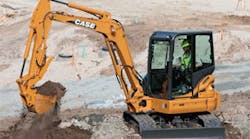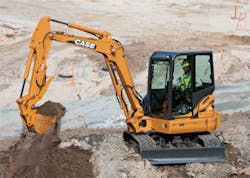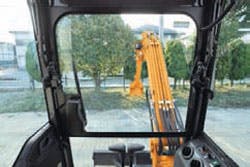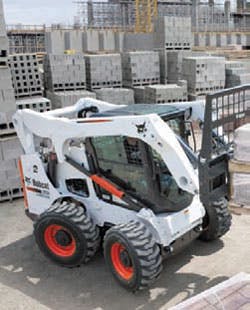The name Case has been well-known in the construction industry for decades. And as with all major manufacturers of construction equipment, parent company CNH America LLC uses hydraulics extensively to transmit power for its heavy equipment used in construction.
Nowhere is this liberal use of hydraulics more evident than in the recently upgraded CX55B compact excavator. The CX55B is powered by a 2.2 l (134 in.3) Yanmar diesel engine that delivers up to 29.3 kW (39.3 hp) @ 2400 rpm and 139.3 N-m (103 lb-ft) of torque @ 1440 rpm. The compact excavator stands only 8-ft high and weighs in at 12, 295 lb (5577 kg), yet it applies a ground pressure of only 4.5 psi.
But don’t let the compact size mislead you. The CX55B’s powerful hydraulic system can accommodate an arm digging force of nearly 5600 lb (25 kN) and bucket digging force of 11,240 lb (50 kN). The long stroke of the hydraulic cylinders also provide a generous work area — a maximum digging radius of 20 ft, 5 in. (6.22 m), maximum digging depth of 12 ft, 10 in. (3.91 m), and an overall reach height of 18 ft, 11 in. (5.76 m).
Hydraulics through and through
In addition to all these work functions, hydraulics also provides propulsion, steering, braking, and swing motion of the cab. As with all crawler drives, steering is accomplished by varying the speed of each track. When necessary, the vehicle can rotate on its center by driving one track forward and the other in reverse.
The CX5B’s engine drives a pair of variable displacement axial-piston pumps, each with a maximum flow capacity of 15 gpm (57.1 lpm). Half of this flow is available for auxiliary functions, which represents a 30% increase over that of the previous model — attributed primarily to a new pump design. Plus, optional secondary auxiliary hydraulics can operate attachments with multiple capabilities or provide a dedicated circuit.
Propulsion is provided by a pair of dual-speed axial-piston motors. In their low-speed setting, the motors can drive the vehicle with maximum torque at a top speed of 1.7 mph (2.7 km/hr). Power is transmitted from each motor to a track drive sprocket through a planetary gear speed reducer. The motor-gearbox combination allows a smaller motor to drive the machine with the required torque. With the CX5B in its high-speed mode, the motors drive the machine at up to 2.9 mph (4.6 km/hr) .
The entire hydraulic system contains 16 gal (61 l) of fluid, with only 9 gal (34 l) held in the system’s reservoir. This reservoir is smaller than what had traditionally been specified because less fluid in the system makes it easier to keep fluid clean. And cleaner hydraulic fluid improves system reliability and component life.
The hydraulic system’s standard relief setting is 3336 psig (23.0 MPa). This high pressure allows smaller actuators to be used that deliver power equivalent to that of larger actuators operating at higher pressure.
And that’s not all. The CX55B also has standard proportional hydraulic control using operator joysticks. A network of pilot lines transmits input and feedback signals as pressurized fluid. Even though electrohydraulic valves are used extensively in mobile hydraulic equipment, the simplicity and reliability of pilot operation are still preferred for a large sector of construction equipment. Electrohydraulic control certainly has its advantages, but electrical cables and connectors can lose contact if exposed to the heavy doses of water, dirt, impact, and vibration typically encountered at construction sites.
Hydraulic functions are controlled through 11 spool-type valves, with pilot control for left and right track travel, boom, arm, bucket, and swing. Pilot pressure on the CX55B is maintained by a 4.0 gpm (15.2 lpm) gear pump with relief pressure set at 514 psig (3.5 MPa). Breaker and backfill blade functions are accomplished using manually operated valves.
A big advantage of the hydraulic control is that hydraulic functions can still be operated even with engine shut down. This functionality is provided by an accumulator circuit that stores hydraulic power. So even in the event of an unexpected engine shutdown, pressure stored in the accumulator can be used to safely lower attachments using in-cab controls.
Actuators at work
The high working forces and long reach capabilities of the CX55B are provided by the high-pressure hydraulics acting on large bore and long stroke cylinders with generously sized piston rods. For example, the boom cylinder has a bore of 3.94 in. (100 mm), with a rod diameter of 2.17 in. (55 mm) and stroke of 26.8 in. (680 mm).
Likewise, the arm cylinder has a comparatively large bore of 3.54 in. (90 mm), rod diameter of 1.97 in. (50 mm), and stroke of 28.9 in. (735 mm). Even the bucket cylinder has nearly a 3-in. bore. It actually has a bore of 2.95 in. (75 mm), rod diameter of 1.57 in. (40 mm), and stroke of 21.4 in. (543 mm).
For more information on the Case CX55, visit http://bit.ly/HP511Case
Compact loader has options galore
Bobcat Co., W. Fargo, N.D., recently redesigned its 770 series of compact loaders to provide higher power and better hydraulic performance than ever before. The 770 series consists of the S770 skid-steer loader; the T770 tracked loader that offers more pushing power, higher tipping loads, and lower ground pressure than a skidsteer; and the A770, which can switch from ultra-maneuverable skid-steering to turf-saving all-wheel steering at the touch of a button.
All three models feature two-speed operation, accomplished with two dual-displacement Bosch Rexroth hydraulic motors, each driving a wheel assembly on either side of the machine. Hydraulic power was increased by specifying a larger hydraulic pump. Pump flow has been increased from 21 to 23 gpm, and relief pressure was increased from 3300 to 3500 psig.
Placement of components was reassessed, and repositioning some of the components within the machine improved hose routing and protection. The results are fewer hydraulic hoses and fittings and potential leakage associated with them.
All-wheel steering is accomplished using a steering cylinder at each wheel. A pivot sensor on each wheel feeds wheel position to an electronic steering controller. The controller then routes just enough hydraulic fluid to each steering cylinder to pivot the respective wheel at the correct angle for the turn radius commanded by the operator. The sensor even positions the wheels so that the pivot angle on the inner radius of the turn is sharper than that of the wheels on the outer radius. This feature helps minimize disturbance to the ground, which is essential when working on construction projects in parks, golf courses, and other landscaped areas.
For more information on the Bobcat A770, visit http://bit.ly/HP511Bobcat.
This article appeared in print as "Redesign provides power and control" in the may 2011 issue of Hydraulics & Pneumatics.




